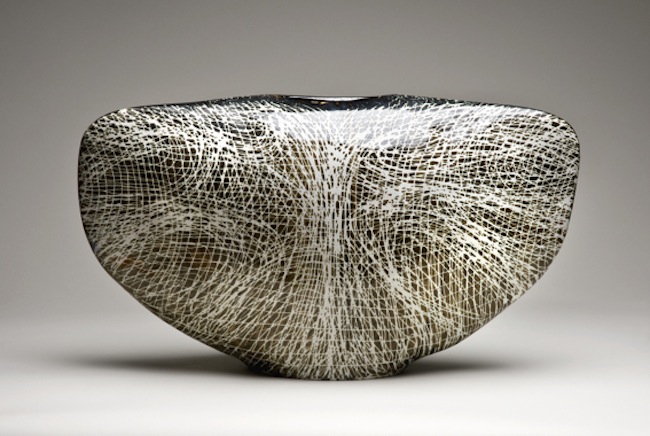James Tower’s work is the subject of an exhibition at Erskine, Hall & Coe (London, February 5-25,2104).
James was an extraordinary man; he always seemed to have time on his side. I never saw him in a flap. His work expresses a quiet but passionate engagement with things; with the making of things and with the state of things.
After early experimentation, influenced by Henry Moore and the studio pottery of the first generation of English modernists, he settled on a few basic forms including the dish and his characteristic flat vases that often look, with their open necks, like thin torsos. On these forms, in the simplest of colours and often a black-grey glaze, he scratched his designs. James made surfaces that came alive and were at once imposed upon, but also part of the convex or concave shapes and forms on which they lived.
From the early drawings in pen you can see James’s nervous line becoming fields of energy. It is this ability to create vectors by the multiple application of lines inscribed through an imposed glazed surface that I think characterises his most successful work.
James lived the latter part of his life outside Lewes in East Sussex, a landscape already celebrated by Paul Nash. A landscape of sea views, chalk downs, streams, cliffs and flinty fields. James and the landscape in which he dwelled were coeval; out of it came his leaves, fish, trees and fields of stones, clouds or spots. The magic of his work is that the relationship between figure and ground is always open. It is not clear whether we are invited to look at the negative or positive; the black or white. Whether the forms left behind are holes, or objects, or whether they are simply the intervals between flow. There is a sense of water running between rocks, patterns on a butterfly’s wings, spots on a fish’s skin, clouds on a wintery day, stripes on a zebra’s back, ribs of a human chest and the multiple leaves of a compressed succulent in the myriad forms of James’s work. His genius was to synthesise and make of these inspirational designs in which he delighted things in themselves. The titles of the works evoke them in: Spume, Currents, Winter Moon, Vortices, Glacier and Pool.
James had the ability to evoke space and to use the surfaces of objects to transform them. If we look at Pool, space itself has been bent. The truth of the form that we touch is countered by the illusion of the space he inscribes upon it, making the bowl into a condensing lens. When we look at the Glacier series, Spume or Sheepfold, we see extraordinary chartings not just of the ways of the natural world but also of a sense in which sight itself, the act of looking, moves across a surface and penetrates it. In a work like Currents it is difficult not to think of the Polynesians’ bamboo sailing charts. This spreading work combines both the sense of cartography with a participation in the moving currents of wind, rain and water, all as if held in the upper breath of a body with lifted arms.
James was a wonderful artist, father and teacher. He was always interested in the inner life of people, places and things and he has left behind a body of work that celebrates this. He was always kind, always willing to lend an ear and always happy to proffer advice but never instruction.
I think of James as a quintessentially English artist, who responded to his environment, was dedicated to his craft and who was a true friend. His works outlive him and for me they represent the very best of English studio ceramics.
Antony Gormley is one of Britain’s greatest contemporary sculptors. Published with permission from Antony Gormley. This essay was published in The Ceramic Art of James Tower by Timothy Wilcox and published by Lund Humphries. Photographs courtesy of Lund Humphries.
Above image: James Tower, Currents, earthenware

James Tower, Glacier, tin-glazed earthenware

James Tower, Spume, tin-glazed earthenware

James Tower, Sheepfold, tin-glazed earthenware
Visit the James Tower exhibition at Erskine, Hall & Coe
Visit the exhibition review in CFile

·You will always find online stores that are offering special
deals, coupons, or some types of discounts. There were no boldly patterned skirts and I tried on dresses instead.
As additional consumer protection, manufacturers have to be certified to provide further proof of their
compliance with the uniform guidelines in the
use of potentially harmful products used in processing raw materials.